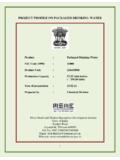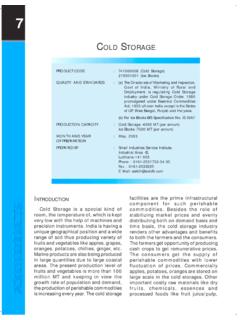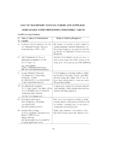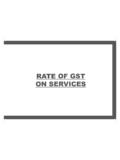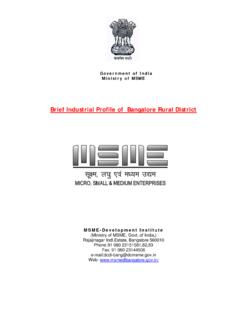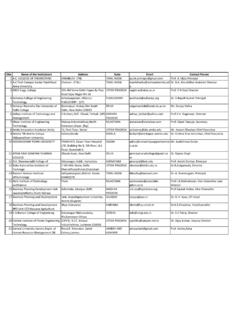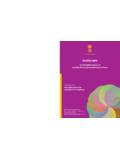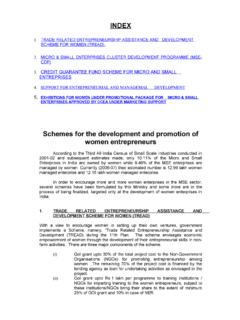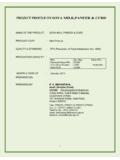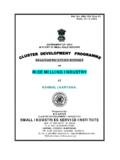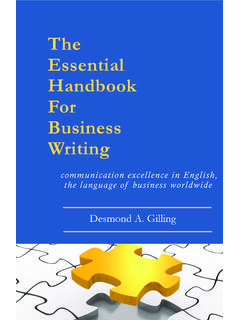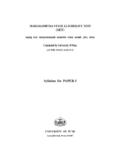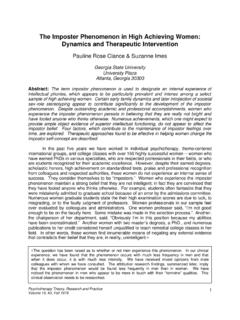Transcription of PROPOSAL FOR SETTING UP OF A COMMON FACILITY …
1 A L U V A P L A S T I C C O N S O R T I U M P V T . L T D . E R U M A T H A L A P O S T A L U V A E R N A K U L A M D I S T R I C T K E R A L A PROPOSAL FOR SETTING UP OF A COMMON FACILITY CENTRE UNDER SMALL INDUSTRIES CLUSTER DEVELOPMENT PROGRAMME SCHEME OF OFFICE OF DC (SSI) UNDER THE TECHNICAL GUIDANCE OF NTTF TECHNICAL TRAINING CENTRE, NETTUR , TELLICHERRY. CONTENTS List of Annexures Executive Summary Abstract of the Project Section I Introduction Section II Technical Aspects Section III Land And Building Section IV Plant and Machinery Section V Man Power Requirements Section VI Other Project Details Section VII Project Particulars Section VIII Financial Aspects Section IX Conclusion And Recommendation LIST OF ANNEXURES 1. Land and Building 11. Plant and Machinery 111.
2 Supporting Equipments IV. Preliminary and Pre-operative Expense V. Utilities VI. Man Power Requirements VII. Consumable Stores VIII. Annual Repair and Maintenance Expenses IX. Phased Revenue Programme X. Computation of Working Capital and Margin Money Requirement XI. Project Cost and Source of Finance XII. Depreciation Staight Line Method XIII. Depreciation Written Down Vakue Method XIV. Profitability Estimates XV. Computation of Income Tax XVI. Cash Flow Statement XVII. Projected Balance Sheet XVIII. Internal Rate Of Return XIX. Break Even Analysis XX. Pay Back Period EXECUTIVE SUMMARY a. Industrial Department of Kerala State Government has identified the plastic cluster at Ernakulam under cluster development programme and approved as SIDO cluster. There are 108 tiny and small scale plastic industrial units functioning in Ernakulam district under SSI sector. In this Cluster Development Programme presently 11 small scale plastic based industries in Ernakulam District have formed a consortium under the name and style of M/S.
3 ALUVA PLASTIC CONSORTIUM PVT. LTD. The remaining plastic industrial units will become a member of this consortium immediately. The Diagnostic Study conducted on this Cluster will found some major issues and recommend certain solutions. The immediate requirements of this cluster is a COMMON FACILITY centre for mould making, mould repairing, machinery repairing, machinery spare parts manufacturing, injection moulding etc. which will benefit the units by way of improving the quality of the products, product differentiation, production cost reduction etc. Thus this CFC will improve the performance of this plastic cluster in total. b. As per the direction of small industries service institute, Ayyanthole , Thrissur, Kerala the consortium approached NTTF technical training centre, Tellicherry which is the competent organisation in die and mould engineering. This report is prepared under the technical guidance of NTTF.
4 C. The total project cost is estimated to be Rs. 460 lakhs of which 70% of fixed capital lakhs can be obtained as grant from Government of India under Small Industries Cluster Development Programme scheme, Rs. 92 lakhs from govt of Kerala and balance Rs. 53 lakhs is to be shared by the beneficiaries and stake holders. The projected performance of this COMMON FACILITY centre for the first eight years of operation is appended. The unit will generate profit from the first year of operation. The project is technically feasible and overall economics of the project is very attractive. d. The active support for the project from the industrial department of Kerala in the form of implementing agency will benefit the plastic based industries at Ernakulam District and especially those in consortium. e. The consortium will provide the necessary land and building for SETTING up this COMMON FACILITY centre as their contribution and execute necessary agreements and undertakings with the implementing agency - Industrial Department of Kerala.
5 F. The day to day operating expense of the COMMON FACILITY centre in terms of electricity charges, labour charges etc. will be borne by the consortium and the required periodic maintenance, modernisation etc. will be met by the corpus fund raised from the profit of the COMMON FACILITY centre. g. The consortium will appoint necessary technical experts and skilled labours for running the COMMON FACILITY centre. SECTION - I INTRODUCTION BACKGROUND Industry Status There are 108 tiny and small scale plastic industrial units functioning in Ernakulam district under SSI sector. The capital investment of these industries vary from 5 to 350 lakhs. Total turn over per annum is about Rs. 380 Crores. Plastic industry in Ernakulam District is creating employment opportunities directly to 1500 persons and indirectly to 700 persons. The power requirement per each unit is around 30 to 150 HP.
6 Presently around eleven small scale plastic based industries have formed a consortium under the name and style of Aluva Plastic Consortium Pvt. Ltd. The remaining units will become the members of this consortium immediately. Major Issues and Immediate Solution Dies are moulds are fabricated to give desired shape to molten mass. Most of the units in this cluster are using moulds for making products. Moulds are necessary for making new products. Production mould are usually made from steel for the usual high pressure moulding that requires heating or cooling channels, strength to resist the forming forces, and wear resistance to withstand the wear of plastics, particularly that which has glass or other abrasive fillers. Now these units are making moulds out side Kerala. Besides the mould makers are duplicating these moulds and there-by-there interests are not protected. More than that the lead-time required for mould making is very high and time required for mould repair is also very high.
7 For encountering these difficulties it is better to start a COMMON centre for making and repairing moulds. Presently there is no FACILITY for repairing machinery and supporting equipments in this cluster. The units have to spend huge amount and time for repairing machineries. Most of the spare parts are brought from North India at higher cost because of middle men. The lead time required for getting spare parts such as screw barrel, nozzles, die clamp, cylinders, gear boxes etc. are very high. There by the machineries have to be shut down for more days and production of the unit is suffered. By providing a COMMON FACILITY centre the cost and time required for maintenance of machineries can be reduced drastically. Most of the member industries in the consortium group are small and tiny. They are not in a position to install latest micro processor control injection moulding machine suitable for meeting big orders.
8 By installing a micro processor controlled injection moulding machine these units can meet big orders. In this context the consortium decided to establish a centralised COMMON FACILITY centre to over come above problems. Benefits for members. The consortium members can utilise this COMMON FACILITY centre for making moulds and there by they can produce fresh items in their units and this will help to increase their market potential. This will also help to compete with manufacturers of other states such as Maharastra, Gujrat, Delhi etc. The injection moulding machine installed in the COMMON FACILITY centre can be utilized by the members in order to cater bulk orders. This COMMON FACILITY centre render the services on the basis of engineering hours. This COMMON FACILITY centre will ultimately help the plastic industries in Ernakulam District to increase it s productivity, improve quality, improve capacity utilisation, improve marketing etc.
9 In other words these small scale industries can produce bulk quality products at competitive rate. Modus of operant The COMMON FACILITY centre provide mold making, mould repair, machinery maintenance, and injection moulding services to members on hourly basis. It charge a nominal amount for meeting operational expenses and making corpus fund for future modernisation, up gradation and sustenance of the plant. If there is any additional spare time available in the centre can be offered to other industrial clusters such as rubber cluster, plywood cluster, rice cluster etc. Thus maximum capacity utilisation can be achieved. The raw material required for making moulds, repairing moulds, repairing machineries etc. will be provided by the individual units. So there is no need of heavy working capital for maintaining inventory. The technical experts in the COMMON FACILITY centre will give the technical specification of the material is to be purchased for making moulds and repairing machineries.
10 They also give the details of quality raw material suppliers. The micro processor controlled injection moulding machine installed in the CFC will help the member units for meeting orders (Export orders) which requires high quality and good appearance. SECTION - II TECHNICAL ASPECTS The word tooling refers to hard ware necessary to produce a particular product. A considerable amount of tooling is the result of work performed by the tool designer. Tooling, as viewed by the tool designer, consist of a vast array of cutting devices, jigs, fixtures dies, gauges, etc., used in normal production. The type of production will determine to a large extent the type of tooling. The most COMMON classification of types of tooling is as follows: 1. Cutting tools, such as drills, reamers, milling cutters, broachers, and taps. 2. Jigs and fixtures for guiding the tool and holding the work piece.
